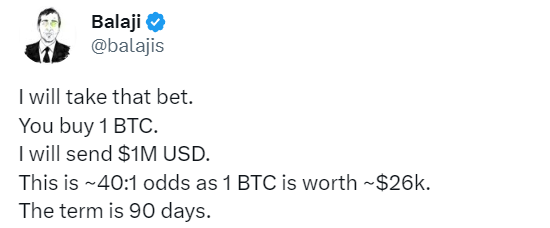Hyperbitcoinization Explained

This blog post will cover:
- What is hyperbitcoinization?
- How can hyperbitcoinization change our world?
- Is hyperbitcoinization coming?
- Conclusion
May of 2023 marked a significant milestone for Bitcoin: the amount of “wholecoiners”, digital wallets with 1 BTC or more reached 1 million. This event was met with a lot of excitement by crypto enthusiasts some of whom even started to theorize about what this means for adopting digital currencies.
In this article, we will talk about a view on the future of the world economy widely discussed in the crypto community – hyperbitcoinization.
What is hyperbitcoinization?
The term ‘hyperbitcoinization' first appeared in 2014. Entrepreneur and Director of Research at Satoshi Nakamoto Institute Daniel Krawisz defined it as ‘Bitcoin-induced currency demonetization’. This means that, according to some specialists, in the future, the first and largest as of date cryptocurrency might oust all traditional currencies and be used for everyday transactions, storing value, etc.
According to the concept’s author, two main factors are at play here:
- Continuous mass crypto adoption;
- Decreased trust in centralized currencies controlled by governments because of worsening inflation.
The hyperbitcoinization theory supposes two variants of how it might happen: within the present-day financial system or outside of it. In the first scenario, governments and financial institutions do not try to hold back the development of cryptocurrencies but instead, lean into it.
And in the case of hyperbitcoinization outside of the system, new BTC-based structures might potentially replace existing central banks, commercial banks, and payment processors. However, the second scenario seems to be somewhat extreme given that governments and financial institutions in many countries are working on their CBDC projects and adopting blockchain technology for various purposes.
How can hyperbitcoinization change our world?
The proponents of hyperbitcoinization see the future of the economy as being Bitcoin circular. In this case, peer-to-peer transactions would replace intermediaries in the form of banks. Individuals and businesses would get an opportunity to interact directly and efficiently even cross-border.
Additionally, BTC supporters point out that micropayments and fractional ownership available thanks to the cryptocurrency, might support new business models and facilitate the economy among other advantages granted by decentralized finance.
Another essential aspect of the Bitcoin circular economy is the fact that transactions are transparent and auditable. The transparent and immutable record of all transactions-related data can potentially help with crime prevention (money laundering, corruption, fraud, etc.)
Is hyperbitcoinization coming?
One more recent event has convinced some people in the crypto community that hyperbitcoinization might be approaching quicker than they thought: three banks (Silicon Value Bank, Silvergate, and Signature) in the US closed one after another in March 2023 causing distress among the banks’ clients and regulators alike.
These events led people to search for a safe haven and transfer their assets to BTC quickly. This even caused a significant spike in the cryptocurrency’s price. The fact that Bitcoin is seen as such also showcases its strong position in the current economy.
Sometimes this faith even turns into rather radical ideas. For example, in March 2023, soon after the bank collapse, former Coinbase CTO, Balaji Srinivasan, started a bet with a Twitter user Medlock in which he argued that if Bitcoin’s price failed to reach $1 million by June, 17, Medlock would receive $1 million.
Eventually, Srinivasan closed the bet early and sent Medlock $500,000. He also donated Bitcoin Core developers, and the non-profit Give Directly $500,000 each. Even though Balaji Srinivasan lost the bet, he is sure still that BTC is the future.
Conclusion
Hyperbitcoinization is a speculative theory, even though the development of the Crypto World shows that it might turn into our shared future. The adjustment of all financial structures will certainly take a while, and also there are such issues as regulatory uncertainty, technical complexity, and price volatility which make the crypto adoption slower, it still seems that the benefits of a BTC-centered global economy are worth finding ways to overcome the challenges. Even more so taking into consideration the fact that there have been cases where a crypto company won against regulators, for example, the lawsuit of the SEC against Ripple. You can read more about this in our article.


